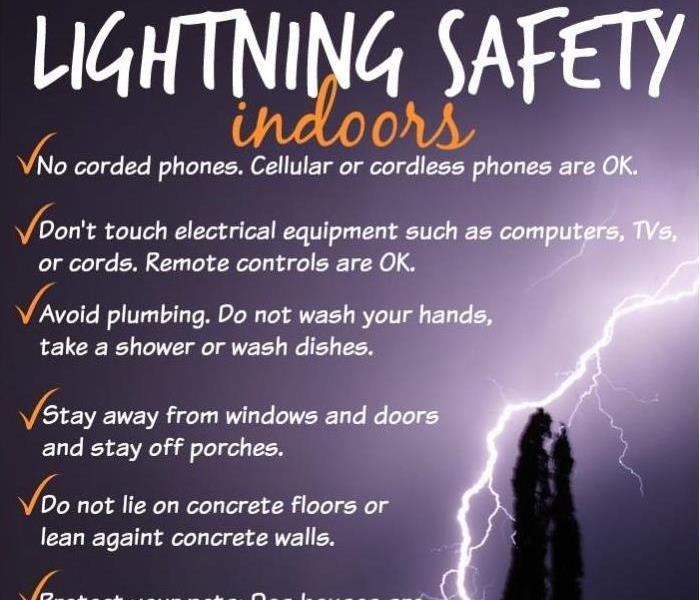"When thunder roars, go indoors!"
6/26/2019 (Permalink)
 Lightning Safety Tips - Remember these tips on staying safe indoors during a storm that has lightning presence or potential!
Lightning Safety Tips - Remember these tips on staying safe indoors during a storm that has lightning presence or potential!
This last week of June is National Lightning Safety Awareness Week. If you follow our facebook page, then you've seen our posts this week about this annual effort to bring awareness to lightning safety.
There are quite a few reputable sources online where you can find information about lightning safety and what you can do in your home, your business, or your community to foster an awareness of the potential for storm damage. It's best not to be caught unaware, so educating yourself and others is key in preventing or minimizing any possible storm damage.
Check out these great websites that have helpful information on lightning safety:
- National Lightning Safety Council
- National Weather Service
- Lightning Protection Institute
- Earth Networks
- National Severe Storms Laboratory
This graphic from the National Oceanic and Atmospheric Administration summarizes what to do when you hear the thunder of an approaching storm.
"When thunder roars, go indoors!"
While this is excellent advice because you are significantly safer indoors during a thunderstorm than you are outdoors, you are still not immune to lightning danger.
Since lightning can strike and travel through different channels that could still reach you indoors, here are some tips to keep your risks to a minimum.
- Do not use corded telephones or other plugged-in appliances! This includes electrical equipment such as computers, TVs, and kitchen appliances like your microwave. Using your cell phone is safe - so long as it is not being charged while you're using it!
- If you are going to unplug any electrical devices to protect them against possible power surges, be sure to unplug them before the storm begins! You don't want to be touching those electrical cords when there is a danger of lightning striking!
- Avoid plumbing, as both water and metal plumbing can conduct electricity from a lightning strike. Take your shower, do your laundry, or wash dishes after the storm has passed.
- Stay away from windows and doors, as they can have small cracks in the frames that could allow lightning in.
- It should go without saying that if you are seeking safety and shelter indoors, you should avoid going out on to porches or balconies.
- Refrain from touching concrete surfaces such as the walls or flooring of your basement or garage - lightning can travel through the metal wires or bars which are used in concrete construction.
- Protect your pets! If you have pets outdoors, bring them inside with you when you seek shelter from the storm.
Remember the 30/30 Rule: If there is less than 30 seconds between a flash of lightning and the sound of thunder, you should seek shelter. Wait at least 30 minutes after the last clap of thunder before leaving shelter if you must go outdoors.
Discuss storm safety and the dangers of lightning with your family so everyone is aware of what to do - and not to do - during a storm. #NationalLightningSafetyAwarenessWeek is a great time to remind everyone of storm safety.
SERVPRO of Glenview wants everyone to be safe during a storm, but if your home suffers #stormdamage, remember that we are #HereToHelp. If you need our fire & water cleanup & restoration services, call 847-832-9300 or visit us online at www.SERVPROglenview.com.





 24/7 Emergency Service
24/7 Emergency Service